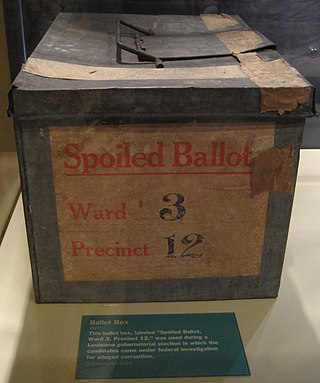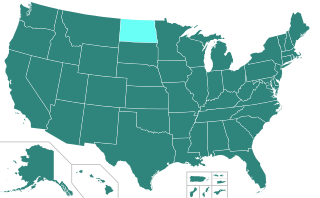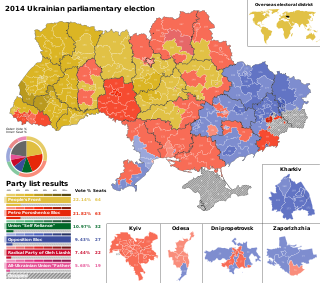
An election is a formal group decision-making process by which a population chooses an individual or multiple individuals to hold public office.

Elections in Sweden are held once every four years. At the highest level, all 349 members of Riksdag, the national parliament of Sweden, are elected in general elections. Elections to the 20 county councils and 290 municipal assemblies – all using almost the same electoral system – are held concurrently with the legislative elections on the second Sunday in September.

Compulsory voting, also called universal civic duty voting or mandatory voting, is the requirement that registered voters participate in an election. As of January 2023, 21 countries have compulsory voting laws. Enforcement of the law in those countries varies considerably and the penalty for not casting a ballot without a proper justification ranges from severe to non-existent.
In political science, voter fatigue is a cause of voter abstention which result from the electorates of representative democracies being asked to vote often, on too many issues or without easy access to relevant information. Voter fatigue can be a symptom of efforts that make voting more difficult that some describe as voter suppression, which changes the voting rules and environment in such a way that turnout decreases as the cost of voting increases.

A protest vote is a vote cast in an election to demonstrate dissatisfaction with the choice of candidates or the current political system. Protest voting takes a variety of forms and reflects numerous voter motivations, including political apathy. Where voting is compulsory, casting a blank vote is available for those who do not wish to choose a candidate, or to protest. Unlike abstention elsewhere, blank votes are counted.

In political science, voter turnout is the participation rate of a given election. This is typically either the percentage of registered voters, eligible voters, or all voting-age people. According to Stanford University political scientists Adam Bonica and Michael McFaul, there is a consensus among political scientists that "democracies perform better when more people vote."
Direct election is a system of choosing political officeholders in which the voters directly cast ballots for the persons or political party that they desire to see elected. The method by which the winner or winners of a direct election are chosen depends upon the electoral system used. The most commonly used systems are the plurality system and the two-round system for single-winner elections, such as a presidential election, and proportional representation for the election of a legislature or executive.

"Get out the vote" or "getting out the vote" (GOTV) describes efforts aimed at increasing the voter turnout in elections. In countries that do not have or enforce compulsory voting, voter turnout can be low, sometimes even below a third of the eligible voter pool. GOTV efforts typically attempt to register voters, then get them to vote, by absentee ballot, early voting or election day voting. GOTV is generally not required for elections when there are effective compulsory voting systems in place, other than perhaps to register first time voters.

Voter suppression is a strategy used to influence the outcome of an election by discouraging or preventing specific groups of people from voting. It is distinguished from political campaigning in that campaigning attempts to change likely voting behavior by changing the opinions of potential voters through persuasion and organization, activating otherwise inactive voters, or registering new supporters. Voter suppression, instead, attempts to gain an advantage by reducing the turnout of certain voters. Suppression is an anti-democratic tactic associated with authoritarianism.
An absentee ballot is a vote cast by someone who is unable or unwilling to attend the official polling station to which the voter is normally allocated. Methods include voting at a different location, postal voting, proxy voting and online voting. Increasing the ease of access to absentee ballots is seen by many as one way to improve voter turnout through convenience voting, though some countries require that a valid reason, such as infirmity or travel, be given before a voter can participate in an absentee ballot. Early voting overlaps with absentee voting. Early voting includes votes cast before the official election day(s), by mail, online or in-person at voting centers which are open for the purpose. Some places call early in-person voting a form of "absentee" voting, since voters are absent from the polling place on election day.

Postal voting is voting in an election where ballot papers are distributed to electors by post, in contrast to electors voting in person at a polling station or electronically via an electronic voting system.

The youth vote in the United States is the cohort of 18–24 year-olds as a voting demographic, though some scholars define youth voting as voters under 30. Many policy areas specifically affect the youth of the United States, such as education issues and the juvenile justice system; however, young people also care about issues that affect the population as a whole, such as national debt and war.
An uncontested election is an election in which the number of candidates is the same as or fewer than the number of places available for election, so that all candidates are guaranteed to be elected. An uncontested single-winner election is one where there is only one candidate. In some uncontested elections, the normal process, of voters casting ballots and election official counting votes, is cancelled as superfluous and costly; in other cases the election proceeds as a formality. There are some election systems where absence of opposing candidates may not guarantee victory; possible factors are a quorum or minimum voter turnout; a none of the above option; or the availability of write-in candidates on the ballot.

Voter registration in the United States is required for voting in federal, state and local elections. The only exception is North Dakota, although cities in North Dakota may register voters for city elections. Voter registration takes place at the county level in many states and at the municipal level in several states. Most states set cutoff dates for voter registration and to update details, ranging from 2 to 4 weeks before an election; while a third of states have Election Day or "same-day" voter registration which enables eligible citizens to register or update their registration when they vote before or on election day.

The question of whether the governance of the European Union (EU) lacks democratic legitimacy has been debated since the time of the European Economic Community in the late 1970s. This led in part to an elected European Parliament being created in 1979 and given the power to approve or reject EU legislation. Since then, usage of the term has broadened to describe newer issues facing the European Union. Voter turnout at the elections to the European Parliament fell consecutively at every election from the first in 1979 up to 2014 when it hit a low of 42.54%, before finally rising in 2019. The 2014 turnout figure is lower than that of any national election in the 27 countries of the European Union, where turnout at national elections averages 68% across the EU.

The historical trends in voter turnout in the United States presidential elections have been determined by the gradual expansion of voting rights from the initial restriction to white male property owners aged 21 or older in the early years of the country's independence to all citizens aged 18 or older in the mid-20th century. Voter turnout in United States presidential elections has historically been higher than the turnout for midterm elections.

There are five types of elections in the United Kingdom: elections to the House of Commons of the United Kingdom, elections to devolved parliaments and assemblies, local elections, mayoral elections, and police and crime commissioner elections. Within each of those categories, there may also be by-elections. Elections are held on Election Day, which is conventionally a Thursday, and under the provisions of the Dissolution and Calling of Parliament Act 2022 the timing of general elections can be held at the discretion of the prime minister during any five-year period. All other types of elections are held after fixed periods, though early elections to the devolved assemblies and parliaments can occur in certain situations. The five electoral systems used are: the single member plurality system (first-past-the-post), the multi-member plurality, the single transferable vote, the additional member system, and the supplementary vote.
The Latino vote or refers to the voting trends during elections in the United States by eligible voters of Latino background. This phrase is usually mentioned by the media as a way to label voters of this ethnicity, and to opine that this demographic group could potentially tilt the outcome of an election, and how candidates have developed messaging strategies to this ethnic group.

Snap parliamentary elections were held in Ukraine on 26 October 2014 to elect members of the Verkhovna Rada. President Petro Poroshenko had pressed for early parliamentary elections since his victory in the presidential elections in May. The July breakup of the ruling coalition gave him the right to dissolve the parliament, so on 25 August 2014 he announced the early election.

Elections to the European Parliament saw declining voter turnout between 1979 and 2014. However, voter turnout in 2019 European elections increased by 8 points compared to 2014. In spite of this exception for all Member States, the electoral mobilization remains weak compared to the national parliamentary elections. Moreover, turnout significantly differs from one country to another in Europe and across a time: in 2019 Belgium citizens participated the most with 88.47% and Slovakians the less with 22.74%. The potential factors that might influence these trends and their implications have attracted great scholarly attention. Identifying and analysing the factors that determine the relative low turnout at European elections is therefore critical, as it is one element that weakens the democratic legitimacy of the European Parliament.














